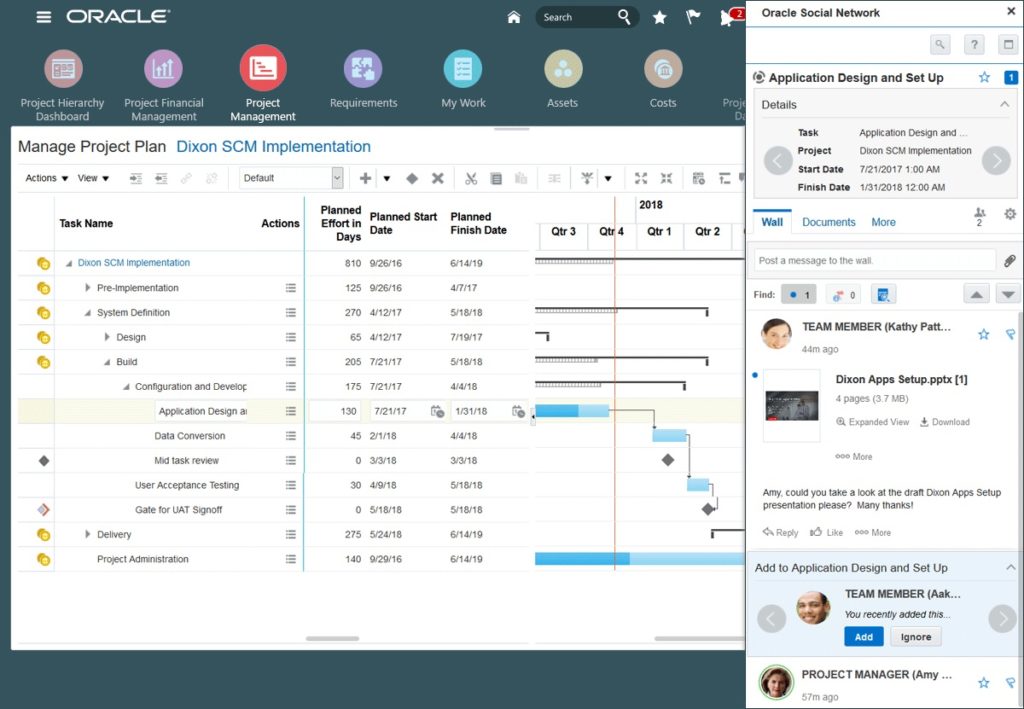
Project Management
Project Management Cloud extends planning and scheduling to the “occasional” project manager; to those who manage projects infrequently and not as their primary role. No longer is planning a specialized skill, only performed by experienced personnel, as more and more people are given projects to manage. Not all planning and scheduling solutions have kept up with this evolution. Oracle Fusion Project Management has been designed from the ground up to address the needs of all project managers, regardless of their level of experience, and can be adopted by all organizations for any type of project work.

Project Portfolio Management Cloud
Project Portfolio Management Cloud software helps you simplify project planning
Planning Made Easy
More experienced project managers can still take advantage of capabilities that include constraint dates and types, dependency types, leads and lags, and the ability to compare the plan with current and historical baselines. And for those requiring a more managed approach to planning, gate management orchestrates critical decision points, polling stakeholders for their input and approval.
Planning is a Collaborative Activity
Team members are closest to the actual work so they should be included in the development of the plan; commonly this means meetings, email, and spreadsheets but these are not effective ways to schedule and collaborate. Oracle Project Management Cloud combined with Oracle Task Management Cloud lets the project manager work with the team to create the plan. Team members are assigned work through the project plan or they can identify the work for themselves or for others on the project. Any work added by the project team is highlighted to the project manager so it can be reviewed and, where appropriate, incorporated into the plan. This ensures works doesn’t fall through the cracks and makes for a more accurate plan.
Social collaboration and project management are merged in Oracle Project Management Cloud, letting project participants interact in real-time through project-specific conversations, and collaboratively upload and review documents. Embedding social capabilities within the business processes, through integration with Oracle Social Network, ensures secure consistent communication across project stakeholders.
Efficiently Manage Project Resources
The ability to assign multiple labor resources to tasks ensures that project managers can maintain project plans that are short and crisp. And where additional resource needs are identified, they can simply be allocated to the project. The project manager can quickly take action to add or request resources, confirm resource assignments, or update resource details, and view labor and expense resources in a graphical card format or in a list view.
Real-time Progress
The combination of Oracle Project Management Cloud and Oracle Task Management Cloud addresses these issues by reducing the time it takes to capture and review progress: Team members can progress their tasks with a single click indicating that a task has started or finished; while project managers reviewing progress, can see who is late submitting their progress and focus on tasks that deviate from the plan, for example to review overdue tasks or proposed changes in dates or effort from team members. The project manager can choose to immediately accept or reject proposed changes or preview the impact on the project schedule before making a decision.
Issue Management
Issues encountered during execution are captured, categorized and prioritized. Any actions that result can be assigned to those on the team for resolution while each issue is traced through different statuses and monitored with analytics that show issue aging and issues by type.
Real-time Reporting
Project milestones can be analyzed in a timeline view to immediately see the milestones that are past due and those requiring action, with the ability to take action to set milestones as complete and for more tailored and ad hoc reporting you can generate real-time reports across your projects using the pre-built project management subject areas and sample reports.
